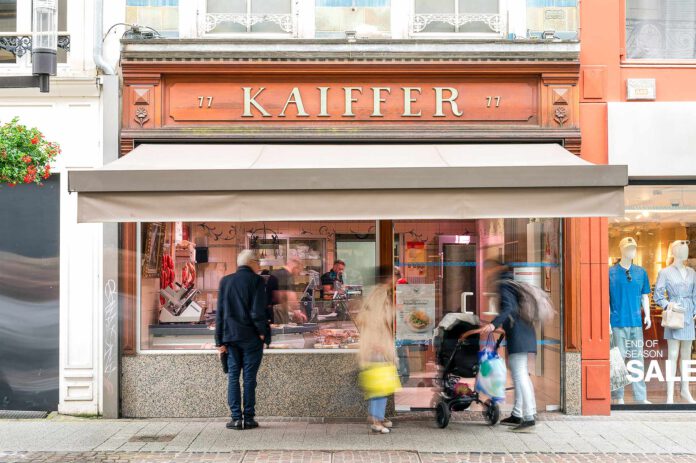Established in 1910, Boucherie Kaiffer is the oldest family-run butcher’s shop in Luxembourg. Now in the fourth generation, Anne Kaiffer has been at the helm since 2014. One thing that hasn’t changed over the course of time, however, is this traditional butcher’s steadfast commitment to quality local and seasonal products and traditional Luxembourgish dishes.
Amidst the ever-changing cityscape, Boucherie Kaiffer has been a mainstay on Luxembourg City’s Grand-Rue for around 70 years. “Towns and cities need to change in order to survive” says Anne Kaiffer. Anne’s great-grandfather opened the first butcher’s shop in Wormeldingen in 1910. “There was also a small bistro next to the shop, as was the norm back then” she says. In around 1950, her great-uncle relocated the business to the Grand-Rue in Luxembourg City. Today, Boucherie Kaiffer is a renowned institution in the capital. Anne also grew up in Luxembourg City. “As a child, I didn’t have much to do with the family business” recalls the master butcher. “With all the knives and machines, it was far too dangerous.But I was always allowed to go down there when the ‘Braderie’ street market was on. I loved doing that!” Yet, Anne was not destined to take over the family business: “Although I always wanted to be a butcher as a child, my father encouraged me to do something else.” And so Anne studied journalism and worked at TV and radio station RTL for a few years. “I enjoyed being a journalist, but after a few years I got bored of reporting on the same old issues time and time again” she says. She briefly toyed with the idea of opening a traditional Luxembourg bistro, but in the end decided to take over the reins of Boucherie Kaiffer.

A traditional trade in a modern world
When we visit the shop on the Grand-Rue on an ordinary Wednesday morning, it is bustling with activity. Four employees are hard at work behind the counter, calmly serving the never-ending stream of customers, with a friendly smile. A typical day in the life of this butcher’s shop. Boucherie Kaiffer attracts a diverse clientele: “We get old Luxembourgers, young people and a lot of expats coming in.Especially on Saturdays” Anne tells us. She’s always surprised at just how many young people ask for traditional meat products like ‘Kuddelfleck’ (a Luxembourgish tripe dish) and ‘Träipen’ (Luxembourgish black pudding). “I recently had a customer in her early twenties asking for a calf’s head — I thought I wasn’t hearing right!”There’s obviously no shortage of customers, but the future of butchery is facing a different threat: a shortage of young people wanting to train in the trade. “Unfortunately, the skilled trades have a very poor reputation in Luxembourg and are often young people’s third or fourth career choice.Bakeries and many other businesses are also suffering from this.It’s such a shame” she says.”It’s a different situation in Switzerland, where I trained.Young people there are happy to secure an apprenticeship and take pride in doing a manual job.”


Focus on quality and sustainability
Boucherie Kaiffer sources its beef and pork exclusively from Luxembourg slaughterhouses that adhere to strict animal husbandry and feeding standards: “How, when and what the animals are fed has a significant impact on the quality of the meat” explains Anne. “That’s why we take great care when choosing our partners.”The mutton on sale in the shop is only sourced in Luxembourg when in season; the rest of the year, it comes from France. This is something they are very transparent about, the master butcher assures us, because customers want to know where their products come from. Of course, sustainability is also a top priority here.They are reducing the amount of plastic they use and using sustainable packaging materials wherever possible:”It’s vital to rethink practices, especially when it comes to packaging.At first, our older customers couldn’t get their heads around getting their stew in a cardboard bowl.But everyone gradually got used to it.” Anne also has strong opinions on the trend towards less meat and more meat substitutes: “I’ve been on training courses and know what’s in these substitute products.They’re mostly soya-based, which is often bad for the

